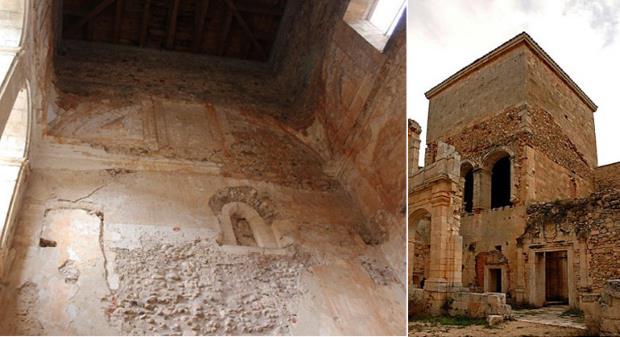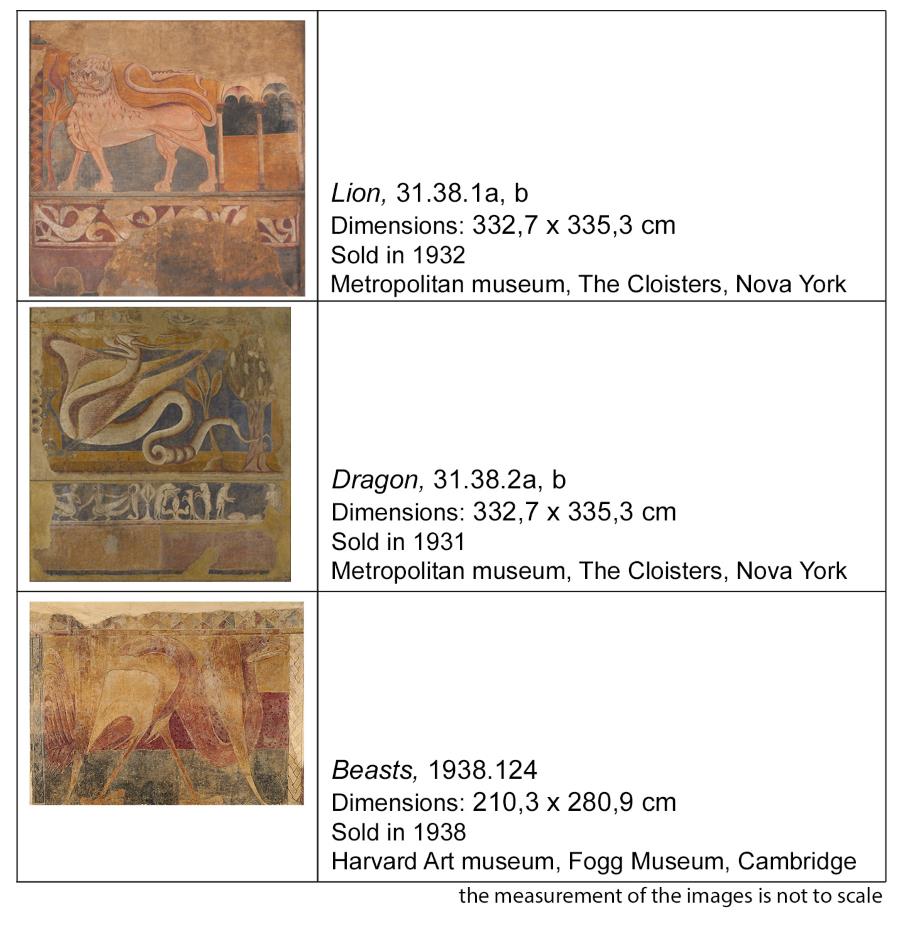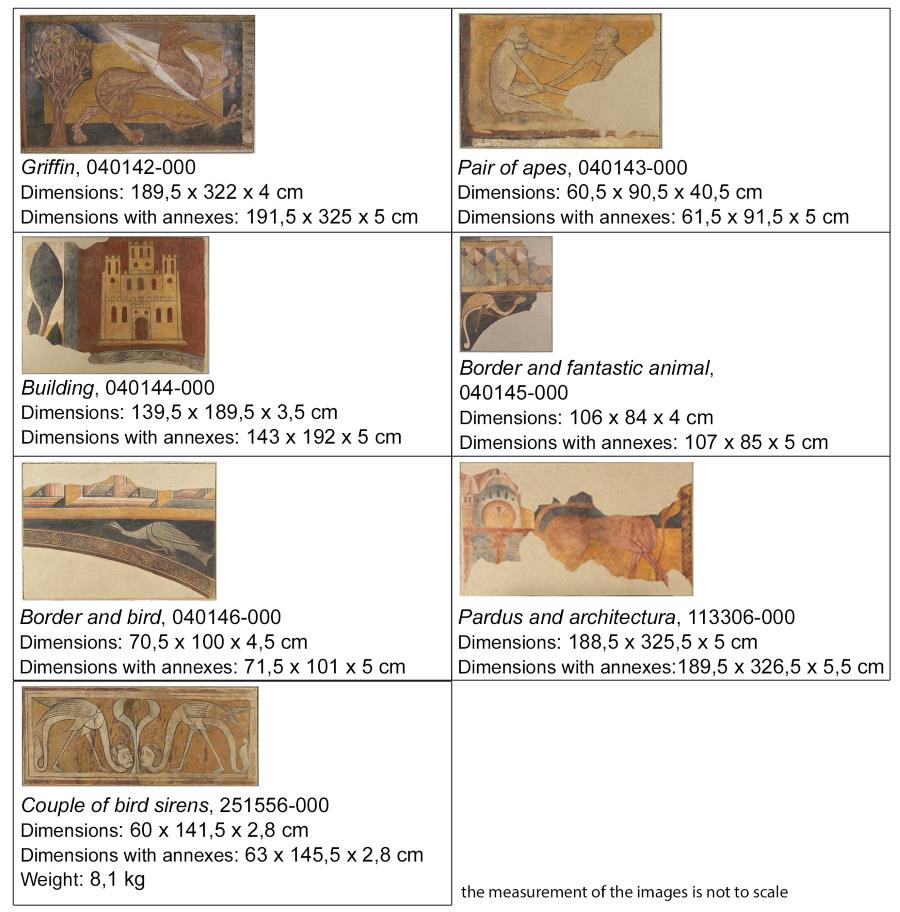Paz Marquès
The recovery and study of works in the museum’s storerooms, which we normally do in the Restoration and Preventive Conservation department, is a quite invisible job, in the eyes of visitors. It is a fascinating task that enables us to interpret pieces that are little known since they have never been exhibited, given that space in the permanent rooms is limited. In this article we shall compare a piece from the permanent exhibition, the Griffin, with a work from the storerooms, Pardus and architecture, both of them fragments of mural painting from San Pedro de Arlanza.
The Monastery of San Pedro de Arlanza: a brief introductory history
The Monastery of San Pedro de Arlanza is in Hortigüela, Burgos, next to the river Arlanza. The monastery church was built around the year 1080, and an outstanding feature of it was a large vault supported by pillars, with three apses at the east end and a tower. It was one of the most important monasteries in Castile and functioned as such until Mendizábal’s disentailment in 1835, when it was abandoned. In the early 20th century, the ruins of this majestic building were visible and the paintings, exposed to the elements, were rapidly deteriorating. By about 1925-1926 the building was a total ruin, but it was declared a Historical-Artistic Monument in 1931.
The mural paintings of Arlanza decorated a rectangular palatine room on the first floor, which was above the chapterhouse in the Treasure tower, next to the church. The roof collapsed and some experts thought, erroneously for some years, that the paintings were part of this chapterhouse. In the 17th century the room with the paintings was renovated and when three arches were opened up on the west side the paintings on that side were lost. When this space was restructured the walls with the murals were chiselled in order to re-plaster them. This chiselling is reflected and visible on the Romanesque paintings, which have holes in them and losses of polychromy.

The Valcárcel family, who owned this architectural site, upon seeing the poor state of general conservation, offered the assets associated with the monastery to different state institutions. Due to the slowness of the bureaucratic response, they decided not to wait any longer and to sell the remains of mural paintings to private individuals in order to prevent even greater deterioration and loss. Josep Gudiol Ricart and his partner Josep Colomines Roca, who had an art shop in Barcelona and had the financial backing of wealthy patrons, Teresa Amatller Cros and Ròmul Bosch i Catarineu, bought the paintings in 1924. And so Josep Gudiol stripped off and transferred the mural paintings in 1928.
The sale of the fragments contributed to the break-up of the group of mural paintings from San Pedro de Arlanza. Despite the new owners’ promise not to sell abroad, Josep Gudiol and Joan Colomines sold them to the Metropolitan Museum of Art, in 1931, which purchased two panels: the Lion and the Dragon. These large fragments were presented to the public in May 1938 when the New York museum opened. That same year, the Fogg Museum at Harvard purchased the other large panel called Imaginary bird or beast.

The Museu Nacional added the fragments from this group to its collection of mural paintings at different times:
- In 1943, through the middleman Josep Gudiol, five fragments were purchased: Griffin, Pair of apes, Architecture, Border and imaginary animal and Border and bird.
- Thirty years later in 1973 Gudiol donated the fragment with Pardus and architecture.
- Pair of bird-mermaids was added in 2015, the product of a long-term loan by a private collector, Sr Antoni Gallardo. This pair had also previously been in Gudiol’s collection.
The group of works in the Museu Nacional are the following:

Here we shall focus on two particular works: Griffin and Pardus and architecture. Griffins or pardus, bird-mermaids, monkeys, birds… these imaginary creatures are part of the Romanesque bestiary. According to medieval iconography the Griffin symbolizes the protector of treasures and precious stones. The animal has two contrasting functions attributed to it: granting life safety and refuge in the form of a sacred tree, and being a strong creature that takes the souls of sinners to Hell.
Some changing fragments of mural painting
Mural painting, whose purpose is the decoration of architectural buildings, deteriorates and is eventually lost as a consequence of the destruction of the buildings for which it was designed. As in the majority of cases throughout history, when these buildings were abandoned without the possibility of removing the paintings, they were damaged and eventually lost. Often, by the time consent was given to strip off the mural paintings, their situation was already critical and the losses were irreversible.
The removal of mural paintings is a profoundly transformative process as it modifies their role as wall decoration. Although this operation avoids their complete disappearance in many cases, the process causes:
- General damage at the time of removal, depending on the state of the walls and the weather.
- A lack of cohesion between their layers.
- The loss of original polychromy and inevitable fragmentation.
- The placing of the transfer cloths that will replace the original support, the wall, and as a consequence the replacement of the mural support with transfer cloths.
- The definitive alteration of the physical and chemical nature of the paint.
- The addition of new restoration materials.
The end result is fragments of mural painting that will never again behave as such. The situation was no different in San Pedro de Arlanza.
As a result, the mural paintings stripped off and transferred become very delicate fragments. Only by constantly controlling the temperature and the levels of relative humidity can the fragments be kept stable; even then, they are highly reactive to any change.
This article is an introduction to the fragments of mural painting from San Pedro de Arlanza. In a second article we shall look in depth at the process of restoration carried out to recover the works in the group.
Related links
A group of Apostles out of place. Mural Paintings from Sant Pere del Burgal / 1
The virtual apse of Sant Climent de Taüll: a shared project
Restauració pintura mural







